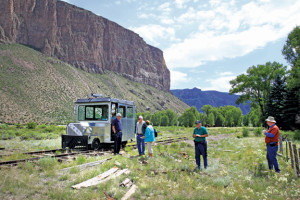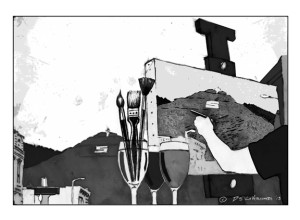Came Men on Horses: The Conquistador Expeditions of Francisco Vázques de Coronado and Don Juan de Oñate
By Stan Hoig
University Press of Colorado
ISBN: 987-1-60732-194-1
$34.95; 352 pages
Reviewed by Virginia McConnell Simmons
Whether you prefer scholarly history or blood-and-thunder stories, Came Men on Horses by Stan Hoig is mesmerizing. If you are looking for a sanitized or romantic account of the conquest of the Southwest, though, this book may not be your choice for bedtime reading. The unvarnished facts about the entradas of Coronado and Oñate, like those of other conquistadors, force readers to some uncomfortable conclusions about human behavior, its cruelty and rapaciousness, but there is evidence of human courage, tenacity and the desire for personal enrichment.
Hoig’s spellbinder recounts, primarily, the expeditions to Nueva Tierra by Francisco Vázques de Coronado and Don Juan de Oñate y Salazar in the 1500s. The text also provides some information about other related 16th-century exploits, such as those of the astonishing survivor Cabeza de Baca, the black Moor Esteban, and the discoverers of the Grand Canyon.
Coronado’s expedition took place in 1540-1542, scarcely a half century after Columbus’s “discovery of America,” and another half century later in 1598, Oñate set forth. The former was seeking Cibola and the Seven Cities of Gold, the subject of widespread myth, as experience proved, and then turned his attention to Quivira. With known information from Coronado’s expedition, Oñate would concentrate on starting Spanish settlement in Tierra Nueva’s Rio Grande country and then quickly continuing in vain the search for Quivira.
Coronado’s circuitous route took him up the mainland not far from the Sea of California, where he vainly expected to have supplies furnished by ship. Having reached Zuni, which obviously was not Cibola, he turned east through the pueblos around present-day Albuquerque and Santa Fe and from there to eastern Kansas, then southwesterly back to Mexico. Supplies for such a journey were soon gone, and the expedition resorted to plundering the pueblos and subsisting on native game and vegetation. Coronado and his men did not enter today’s Colorado, contrary to some written sources, but they covered and described a vast amount of land, even if they were not entirely sure what they were seeing or where they were. He returned home in disgrace because of the conduct of his men and himself.
Oñate’s entrada differed in many respects from Coronado’s, though certainly not in their rapaciousness or cruelty. With proper authorization but no funding by the crown, Oñate’s party set forth with property-owning companions, soldiers and cavalry, assorted opportunists with nothing to lose, slaves with freedom to gain, and large quantities of livestock and equipment. Paul Horgan’s classic Great River includes a detailed list of the personal possession taken along by one of the wealthy companions. Oñate himself was investing his wealth that came from the dowry of his wife, the great-granddaughter of Moctezuma and the granddaughter of Cortez. The conquistadors were investors expecting to benefit from anticipated opportunities, especially land.
The expedition did take formal possession of Nuevo Mexico for the crown soon after crossing the Rio Grande, but otherwise the venture failed. While Oñate resumed the futile search for Quivira, the colony was falling apart. By 1601 most had deserted despite the prospect of severe penalties when they reached Mexico. Oñate defied being removed until 1609, when, like Coronado, Oñate returned to Mexico in disgrace.
The late Stan Hoig, who died before the publication of this book, authored numerous other histories about the American West, which are based on exhaustive research in archival sources and the findings of recognized scholars like Bolton, Hammond and Rey, and many others. Hoig’s Came Men on Horses is comprehensive, accurate and useful with notes, appendixes and index. And, far from least, Hoig wrote readable narrative, typical of all his writing. He will be missed.
Virginia McConnell Simmons writes history in the San Luis Valley.




